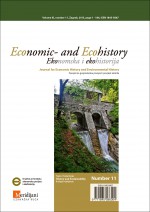How Winter Tourism Transformed Agrarian Livelihoods in an Alpine Village. The Case of Damüls in Vorarlberg/Austria
How Winter Tourism Transformed Agrarian Livelihoods in an Alpine Village. The Case of Damüls in Vorarlberg/Austria
Author(s): Robert Gross, Verena WiniwarterSubject(s): Human Ecology, Rural and urban sociology, Environmental interactions, Tourism, Socio-Economic Research
Published by: Društvo za hrvatsku ekonomsku povijest i ekohistoriju - Izdavačka kuća Meridijani
Keywords: Damüls / Austria; Environmental History; Sustainability; Long-Term-Socio- Ecological-Research; Winter Sports; Alpine History;
Summary/Abstract: Winter after winter, hundreds of thousands of skiers visit Alpine communities to experience bodilymediated landscape sensations. Studying Damüls, a well-known ski resort in Austria’s westernmost province Vorarlberg, we can show that both massive economic growth and massive interventions into Alpine landscapes accompanied winter tourism development. We narrate the environmental history of Damüls over 200 years by analysing strategies of commodification of »nature« and property rights, shedding light on the potentials and pitfalls of sustainable development of remote Alpine communities when they draw their income from winter tourism. The paper investigates how inhabitants dealt with changing environmental and economic conditions in a pre-industrial era. Settlers experienced resource limitations typical for an agrarian society. When the valleys were industrialized, Damüls nearly vanished as a permanent settlement. Then, tourists entered the stage, turning the wheel of local development into a different direction in several steps. Travel writers and photographers had integrated Damüls into the mental topography of urban leisure seekers in the 19th century. A romantic tourist gaze of Damüls developed. From the 1930s onwards, federal authorities discovered the economic power of tourism to improve national trade balances and fostered the tourism transformation. While the impact of tourism was modest in the interwar years due to limited capital and energy availability, these limitations were lifted when the ‘1950s syndrome’ arrived. This third step was characterized by a massive building boom, influencing even inherited property rights. Ski lifts, hotels, roads and later snow systems and ski slope-buildings mushroomed, providing comfortable access to snow-secure Alpine landscapes. The maintenance of this infrastructure requires energy and capital investments, leading to material and energy flows that depend on the availability of cheap energy in large amounts. Agrarian Damüls produced a very modest surplus, depending on available labour input. Touristic Damüls gobbles up energy to provide for tourists leading to a much greater economic gain, but with a considerable impact on natural systems. A sustainable future of Alpine settlements requires new forms of dealing with Alpine nature, forms that are less dependent on the industrialized, globalized system of mobility of people, energy and matter that leads to greenhouse gas emissions, pollution and habitat destruction.
Journal: Ekonomska i ekohistorija - Časopis za gospodarsku povijest i povijest okoliša
- Issue Year: 2015
- Issue No: 11
- Page Range: 43-63
- Page Count: 21
- Language: English

